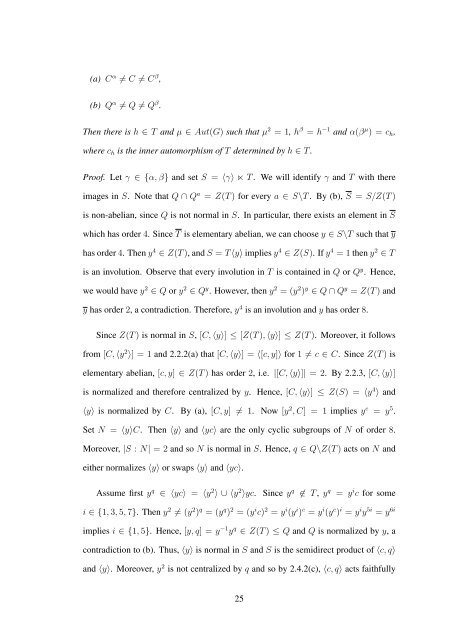SATURATED FUSION SYSTEMS OF ESSENTIAL RANK 1
SATURATED FUSION SYSTEMS OF ESSENTIAL RANK 1
SATURATED FUSION SYSTEMS OF ESSENTIAL RANK 1
Create successful ePaper yourself
Turn your PDF publications into a flip-book with our unique Google optimized e-Paper software.
(a) C α �= C �= C β ,<br />
(b) Q α �= Q �= Q β .<br />
Then there is h ∈ T and µ ∈ Aut(G) such that µ 2 = 1, h β = h −1 and α(β µ ) = ch,<br />
where ch is the inner automorphism of T determined by h ∈ T .<br />
Proof. Let γ ∈ {α, β} and set S = 〈γ〉 ⋉ T . We will identify γ and T with there<br />
images in S. Note that Q ∩ Q a = Z(T ) for every a ∈ S\T . By (b), S = S/Z(T )<br />
is non-abelian, since Q is not normal in S. In particular, there exists an element in S<br />
which has order 4. Since T is elementary abelian, we can choose y ∈ S\T such that y<br />
has order 4. Then y 4 ∈ Z(T ), and S = T 〈y〉 implies y 4 ∈ Z(S). If y 4 = 1 then y 2 ∈ T<br />
is an involution. Observe that every involution in T is contained in Q or Q y . Hence,<br />
we would have y 2 ∈ Q or y 2 ∈ Q y . However, then y 2 = (y 2 ) y ∈ Q ∩ Q y = Z(T ) and<br />
y has order 2, a contradiction. Therefore, y 4 is an involution and y has order 8.<br />
Since Z(T ) is normal in S, [C, 〈y〉] ≤ [Z(T ), 〈y〉] ≤ Z(T ). Moreover, it follows<br />
from [C, 〈y 2 〉] = 1 and 2.2.2(a) that [C, 〈y〉] = 〈[c, y]〉 for 1 �= c ∈ C. Since Z(T ) is<br />
elementary abelian, [c, y] ∈ Z(T ) has order 2, i.e. |[C, 〈y〉]| = 2. By 2.2.3, [C, 〈y〉]<br />
is normalized and therefore centralized by y. Hence, [C, 〈y〉] ≤ Z(S) = 〈y 4 〉 and<br />
〈y〉 is normalized by C. By (a), [C, y] �= 1. Now [y 2 , C] = 1 implies y c = y 5 .<br />
Set N = 〈y〉C. Then 〈y〉 and 〈yc〉 are the only cyclic subgroups of N of order 8.<br />
Moreover, |S : N| = 2 and so N is normal in S. Hence, q ∈ Q\Z(T ) acts on N and<br />
either normalizes 〈y〉 or swaps 〈y〉 and 〈yc〉.<br />
Assume first y q ∈ 〈yc〉 = 〈y 2 〉 ∪ 〈y 2 〉yc. Since y q �∈ T , y q = y i c for some<br />
i ∈ {1, 3, 5, 7}. Then y 2 �= (y 2 ) q = (y q ) 2 = (y i c) 2 = y i (y i ) c = y i (y c ) i = y i y 5i = y 6i<br />
implies i ∈ {1, 5}. Hence, [y, q] = y −1 y q ∈ Z(T ) ≤ Q and Q is normalized by y, a<br />
contradiction to (b). Thus, 〈y〉 is normal in S and S is the semidirect product of 〈c, q〉<br />
and 〈y〉. Moreover, y 2 is not centralized by q and so by 2.4.2(c), 〈c, q〉 acts faithfully<br />
25

















